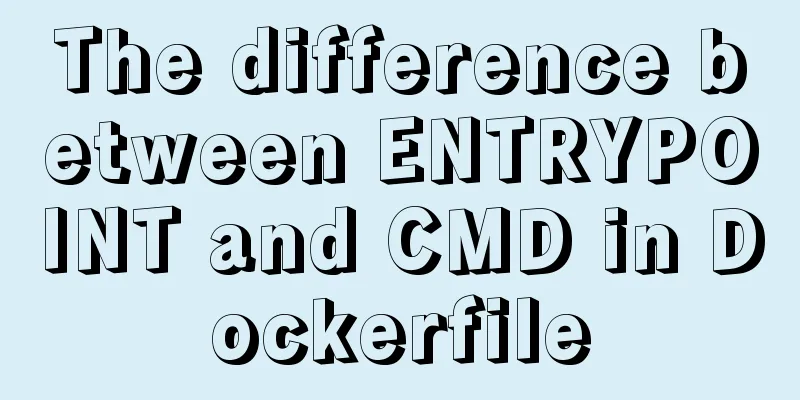The pitfall of MySQL numeric type auto-increment

|
When designing table structures, numeric types are one of the most common types, but using numeric types well is not as simple as imagined, for example:
All of the above are wrong! Although the numeric type may seem simple, the above-mentioned problem of "incomplete design thinking" is easy to occur in the design of table structure architecture (especially in the case of massive concurrent Internet scenarios). Number Types Integer TypesThe MySQL database supports the integer types supported by the SQL standard: INT and SMALLINT. In addition, the MySQL database also supports integer types such as TINYINT, MEDIUMINT, and BIGINT (Table 1 shows the storage space and value range of various integer types):
In the integer type, there are signed and unsigned attributes, which represent the value range of the integer, and the default is signed. When designing, I do not recommend that you deliberately use unsigned attributes, because when doing some data analysis, the results returned by SQL may not be the results you want. Let’s take a look at an example of a “sales table”, whose table structure and data are as follows. It is important to note that the column sale_count uses the unsigned attribute (that is, the column is designed to store values greater than or equal to 0):
mysql> SHOW CREATE TABLE sale_G
*************************** 1. row ***************************
Table: sale
Create Table: CREATE TABLE `sale` (
`sale_date` date NOT NULL,
`sale_count` int unsigned DEFAULT NULL,
PRIMARY KEY (`sale_date`)
) ENGINE=InnoDB DEFAULT CHARSET=utf8mb4 COLLATE=utf8mb4_general_ci
1 row in set (0.00 sec)
mysql> SELECT * FROM sale;
+------------+------------+
| sale_date | sale_count |
+------------+------------+
| 2020-01-01 | 10000 |
| 2020-02-01 | 8000 |
| 2020-03-01 | 12000 |
| 2020-04-01 | 9000 |
| 2020-05-01 | 10000 |
| 2020-06-01 | 18000 |
+------------+------------+
6 rows in set (0.00 sec)
Among them, sale_date represents the date of sale, and sale_count represents the sales quantity per month. Now there is a requirement that the boss wants to count the changes in monthly sales volume to make business decisions. This SQL statement requires a non-equijoin, but it's not too difficult to write:
SELECT
s1.sale_date, s2.sale_count - s1.sale_count AS diff
FROM
sale s1
LEFT JOIN
sale s2 ON DATE_ADD(s2.sale_date, INTERVAL 1 MONTH) = s1.sale_date
ORDER BY sale_date;
However, during the execution, because the column sale_count uses the unsigned attribute, the following result is thrown:
As you can see, MySQL prompts the user that the calculated result is out of range. In fact, MySQL requires that unsigned values remain unsigned after subtraction, otherwise an error will be reported. To avoid this error, you need to set the database parameter sql_mode to NO_UNSIGNED_SUBTRACTION to allow the subtraction result to be signed, so that you can get the final desired result:
mysql> SET sql_mode='NO_UNSIGNED_SUBTRACTION';
Query OK, 0 rows affected (0.00 sec)
SELECT
s1.sale_date,
IFNULL(s2.sale_count - s1.sale_count,'') AS diff
FROM
sale s1
LEFT JOIN sale s2
ON DATE_ADD(s2.sale_date, INTERVAL 1 MONTH) = s1.sale_date
ORDER BY sale_date;
+------------+-------+
| sale_date | diff |
+------------+-------+
| 2020-01-01 | |
| 2020-02-01 | 2000 |
| 2020-03-01 | -4000 |
| 2020-04-01 | 3000 |
| 2020-05-01 | -1000 |
| 2020-06-01 | -8000 |
+------------+-------+
6 rows in set (0.00 sec)
Floating point types and high precision types In addition to integer types, commonly used digital types include floating-point and high-precision types.
The high-precision DECIMAL type among the numeric types can be used. When declaring a column of this type, you can (and usually must) specify the precision and scale, for example: salary DECIMAL(8,2) Where 8 is the precision (precision means the number of leading digits stored in the value) and 2 is the scale (scale means the number of digits stored after the decimal point). Usually in table structure design, the DECIMAL type can be used to represent user salaries, account balances, and other services accurate to 2 decimal places. However, when used in massively concurrent Internet businesses, the DECIMAL type is not recommended for the amount field. Instead, the INT integer type is recommended (the reasons will be analyzed below). Practical Design of Business Table Structure Integer type and auto-increment design In real business scenarios, integer types are most commonly used to represent the quantity of an item in business. For example, the sales quantity in the above table, or the inventory quantity and purchase frequency in e-commerce. In business, another common and important use of integer types is as the primary key of a table, that is, to uniquely identify a row of data.
From Table 1, we can see that the maximum range of INT is at the level of 4.2 billion. In the application of real Internet business scenarios, it is easy to reach the maximum value. For example, some flow tables and log tables have a daily data volume of 10 million. After 420 days, the upper limit of the INT type will be reached.
mysql> CREATE TABLE t (
-> a INT AUTO_INCREMENT PRIMARY KEY
-> );
mysql> INSERT INTO t VALUES (2147483647);
Query OK, 1 row affected (0.01 sec)
mysql> INSERT INTO t VALUES (NULL);
ERROR 1062 (23000): Duplicate entry '2147483647' for key 't.PRIMARY'
It can be seen that when the INT upper limit is reached, a duplicate error will be reported when the auto-increment insertion is performed again, and the MySQL database will not automatically reset it to 1.
mysql> SELECT * FROM t;
+---+
| a |
+---+
| 1 |
| 2 |
| 3 |
+---+
3 rows in set (0.01 sec)
mysql> DELETE FROM t WHERE a = 3;
Query OK, 1 row affected (0.02 sec)
mysql> SHOW CREATE TABLE t\G
*************************** 1. row ***************************
Table: t
Create Table: CREATE TABLE `t` (
`a` int NOT NULL AUTO_INCREMENT,
PRIMARY KEY (`a`)
) ENGINE=InnoDB AUTO_INCREMENT=4 DEFAULT CHARSET=utf8mb4 COLLATE=utf8mb4_general_ci
1 row in set (0.00 sec
It can be seen that after deleting the record with the auto-increment value of 3, the next auto-increment value is still 4 (AUTO_INCREMENT=4). There is no error here, and the auto-increment will not be backtracked. However, if the database is restarted at this time, the starting value of the auto-increment of table t will become 3 again after the database is started, that is, the auto-increment value will be backtracked. The details are as follows:
mysql> SHOW CREATE TABLE t\G
*************************** 1. row ***************************
Table: t
Create Table: CREATE TABLE `t` (
`a` int NOT NULL AUTO_INCREMENT,
PRIMARY KEY (`a`)
) ENGINE=InnoDB AUTO_INCREMENT=3 DEFAULT CHARSET=utf8mb4 COLLATE=utf8mb4_general_ci
1 row in set (0.00 s
To completely solve this problem, there are two methods:
In fact, in the process of designing massive Internet architecture, in order to better scalability of distributed architecture in the future, it is not recommended to use integer type as primary key, and string type is more recommended. Funds field design In the business design of user balance, fund account balance, digital wallet, change, etc., since the fields are all capital fields, programmers usually use the DECIMAL type as the field selection, because this can be accurate to the minute, such as: DECIMAL(8,2). CREATE TABLE User ( userId BIGINT AUTO_INCREMENT, money DECIMAL(8,2) NOT NULL, ...... ) In the design standards for massive Internet services, the DECIMAL type is not recommended. Instead, it is recommended to convert DECIMAL to an integer type. In other words, it is recommended to store funds in cents rather than yuan. For example, 1 yuan is stored as integer type 100 in the database. If the value range of the amount field is expressed using DECIMAL, how do you define the length? Because the DECIMAL type is a variable-length field, if you want to define an amount field, it is not enough to define it as DECIMAL(8,2). This can only mean that the maximum storage value is 999999.99, which means millions of funds can be stored. The user's amount must be stored in a field of at least tens of billions, while the GDP amount field of the Statistics Bureau may reach tens of trillions. It is difficult to unify the definition using the DECIMAL type. Fields are stored in separate storage, but even so, BIG INT can store amounts in the gigabytes. Here, 1 trillion = 1 trillion. The advantage of this is that all amount-related fields are fixed-length fields, occupying 8 bytes, and are highly efficient in storage. Another point is that direct integer calculation is more efficient. Let's look at how records are stored in the database, roughly as follows: If an update occurs, the original space of record 1 cannot accommodate the storage space of record 1 after the update. Therefore, the database will mark record 1 as deleted and find new space for record 1, such as: In the above figure, *Record 1 indicates the space originally occupied by record 1, and this space will become fragmented space and cannot be used anymore unless the table space is manually defragmented. So, when using BIG INT to store an amount field, how do you represent the data in the decimal point? In fact, this part can be completely handled and displayed by the front end. As for the database itself, it only needs to be stored by points. This is the end of this article about the pitfalls of MySQL numeric type auto-increment. For more relevant content about MySQL numeric type auto-increment, please search for previous articles on 123WORDPRESS.COM or continue to browse the following related articles. I hope you will support 123WORDPRESS.COM in the future! You may also be interested in:
|
<<: JavaScript to achieve window display effect
>>: Web page experience: planning and design
Recommend
Summary of commonly used time, date and conversion functions in Mysql
This article mainly summarizes some commonly used...
Detailed installation steps for MySQL 8.0.11
This article shares the installation steps of MyS...
How to build an ELK log system based on Docker
Background requirements: As the business grows la...
The most commonly used HTML escape sequence
In HTML, <, >, &, etc. have special mean...
Tutorial on building a JMeter+Grafana+influxdb visual performance monitoring platform in docker environment
Table of contents 1. Install Docker 2. Install an...
How to implement responsiveness in Vue source code learning
Table of contents Preface 1. Key Elements of a Re...
MySQL compression usage scenarios and solutions
Introduction Describes the use cases and solution...
Database issues and pitfalls in connecting to cloud servers with Navicat Premium15
When using a cloud server, we sometimes connect t...
mysql5.7.19 winx64 installation and configuration method graphic tutorial (win10)
The installation tutorial of mysql 5.7.19 winx64 ...
HTML web page image tag
Insert image tag <IMG> The colorful web page...
JavaScript object built-in objects, value types and reference types explained
Table of contents Object Object Definition Iterat...
MySQL initialization password operation under Mac
A simple record of the database startup problems ...
Detailed steps to install the specified version of docker (1.12.6) using rpm
1. Reasons If the system is Centos7.3, the Docker...
A brief discussion on the role of HTML empty links
Empty link: That is, there is no link with a targ...
Master-slave synchronous replication configuration of MySQL database under Linux
The advantage of the master-slave synchronization...









